Chase Grammer School Network Project: Internetworking Solutions
VerifiedAdded on 2023/04/21
|9
|1737
|438
Project
AI Summary
This project outlines the development of a unified network solution for Chase Grammer School, aiming to enhance the efficiency of both wired and wireless networks. It addresses challenges such as bandwidth allocation, user prioritization, and transmission speed requirements. The solution employs a user-centric design concept, involving iterative phases of specification, requirement identification, design creation, and evaluation. Key hardware components include Cisco routers and switches, along with DHCP and web servers. The project's outcome is to provide improved network performance and security, with limitations acknowledged and future improvements suggested. A network prototype is designed and tested using Netsim, demonstrating the proposed solution's viability and potential.

Running head: OVERVIEW OF INTERNETWORKING
Overview of Internetworking
Name of the Student
Name of the University
Author’s Note
Overview of Internetworking
Name of the Student
Name of the University
Author’s Note
Paraphrase This Document
Need a fresh take? Get an instant paraphrase of this document with our AI Paraphraser

1
OVERVIEW OF INTERNETWORKING
Table of Contents
Project Scope.........................................................................................................................................2
Challenges.............................................................................................................................................2
User Centric Design Concept.................................................................................................................2
Project hardware Requirement.............................................................................................................3
Network design in netsim......................................................................................................................5
Outcomes..............................................................................................................................................5
Limitations.............................................................................................................................................5
Conclusion.............................................................................................................................................6
Demonstration......................................................................................................................................6
Bibliography...........................................................................................................................................8
OVERVIEW OF INTERNETWORKING
Table of Contents
Project Scope.........................................................................................................................................2
Challenges.............................................................................................................................................2
User Centric Design Concept.................................................................................................................2
Project hardware Requirement.............................................................................................................3
Network design in netsim......................................................................................................................5
Outcomes..............................................................................................................................................5
Limitations.............................................................................................................................................5
Conclusion.............................................................................................................................................6
Demonstration......................................................................................................................................6
Bibliography...........................................................................................................................................8
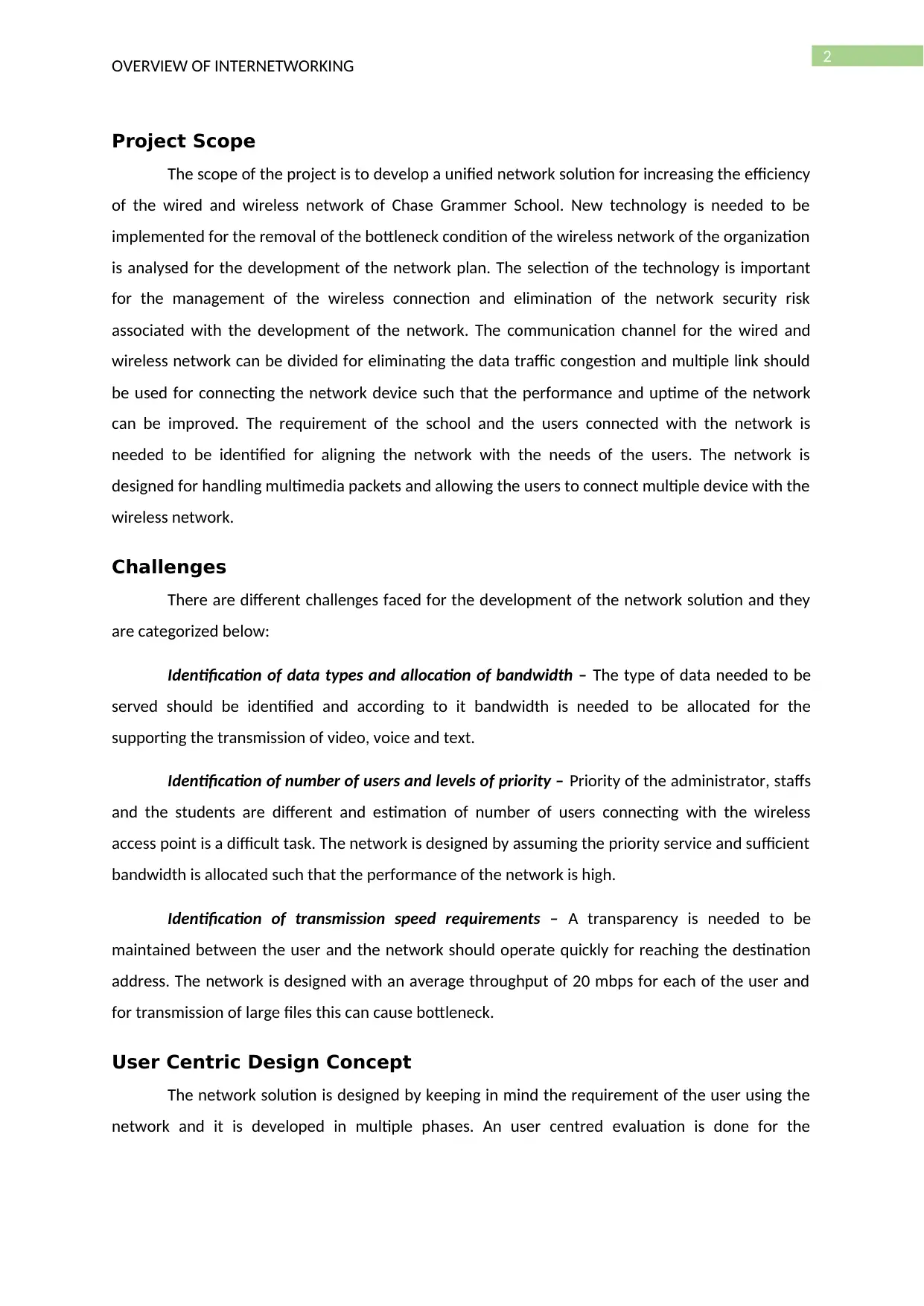
2
OVERVIEW OF INTERNETWORKING
Project Scope
The scope of the project is to develop a unified network solution for increasing the efficiency
of the wired and wireless network of Chase Grammer School. New technology is needed to be
implemented for the removal of the bottleneck condition of the wireless network of the organization
is analysed for the development of the network plan. The selection of the technology is important
for the management of the wireless connection and elimination of the network security risk
associated with the development of the network. The communication channel for the wired and
wireless network can be divided for eliminating the data traffic congestion and multiple link should
be used for connecting the network device such that the performance and uptime of the network
can be improved. The requirement of the school and the users connected with the network is
needed to be identified for aligning the network with the needs of the users. The network is
designed for handling multimedia packets and allowing the users to connect multiple device with the
wireless network.
Challenges
There are different challenges faced for the development of the network solution and they
are categorized below:
Identification of data types and allocation of bandwidth – The type of data needed to be
served should be identified and according to it bandwidth is needed to be allocated for the
supporting the transmission of video, voice and text.
Identification of number of users and levels of priority – Priority of the administrator, staffs
and the students are different and estimation of number of users connecting with the wireless
access point is a difficult task. The network is designed by assuming the priority service and sufficient
bandwidth is allocated such that the performance of the network is high.
Identification of transmission speed requirements – A transparency is needed to be
maintained between the user and the network should operate quickly for reaching the destination
address. The network is designed with an average throughput of 20 mbps for each of the user and
for transmission of large files this can cause bottleneck.
User Centric Design Concept
The network solution is designed by keeping in mind the requirement of the user using the
network and it is developed in multiple phases. An user centred evaluation is done for the
OVERVIEW OF INTERNETWORKING
Project Scope
The scope of the project is to develop a unified network solution for increasing the efficiency
of the wired and wireless network of Chase Grammer School. New technology is needed to be
implemented for the removal of the bottleneck condition of the wireless network of the organization
is analysed for the development of the network plan. The selection of the technology is important
for the management of the wireless connection and elimination of the network security risk
associated with the development of the network. The communication channel for the wired and
wireless network can be divided for eliminating the data traffic congestion and multiple link should
be used for connecting the network device such that the performance and uptime of the network
can be improved. The requirement of the school and the users connected with the network is
needed to be identified for aligning the network with the needs of the users. The network is
designed for handling multimedia packets and allowing the users to connect multiple device with the
wireless network.
Challenges
There are different challenges faced for the development of the network solution and they
are categorized below:
Identification of data types and allocation of bandwidth – The type of data needed to be
served should be identified and according to it bandwidth is needed to be allocated for the
supporting the transmission of video, voice and text.
Identification of number of users and levels of priority – Priority of the administrator, staffs
and the students are different and estimation of number of users connecting with the wireless
access point is a difficult task. The network is designed by assuming the priority service and sufficient
bandwidth is allocated such that the performance of the network is high.
Identification of transmission speed requirements – A transparency is needed to be
maintained between the user and the network should operate quickly for reaching the destination
address. The network is designed with an average throughput of 20 mbps for each of the user and
for transmission of large files this can cause bottleneck.
User Centric Design Concept
The network solution is designed by keeping in mind the requirement of the user using the
network and it is developed in multiple phases. An user centred evaluation is done for the
⊘ This is a preview!⊘
Do you want full access?
Subscribe today to unlock all pages.

Trusted by 1+ million students worldwide
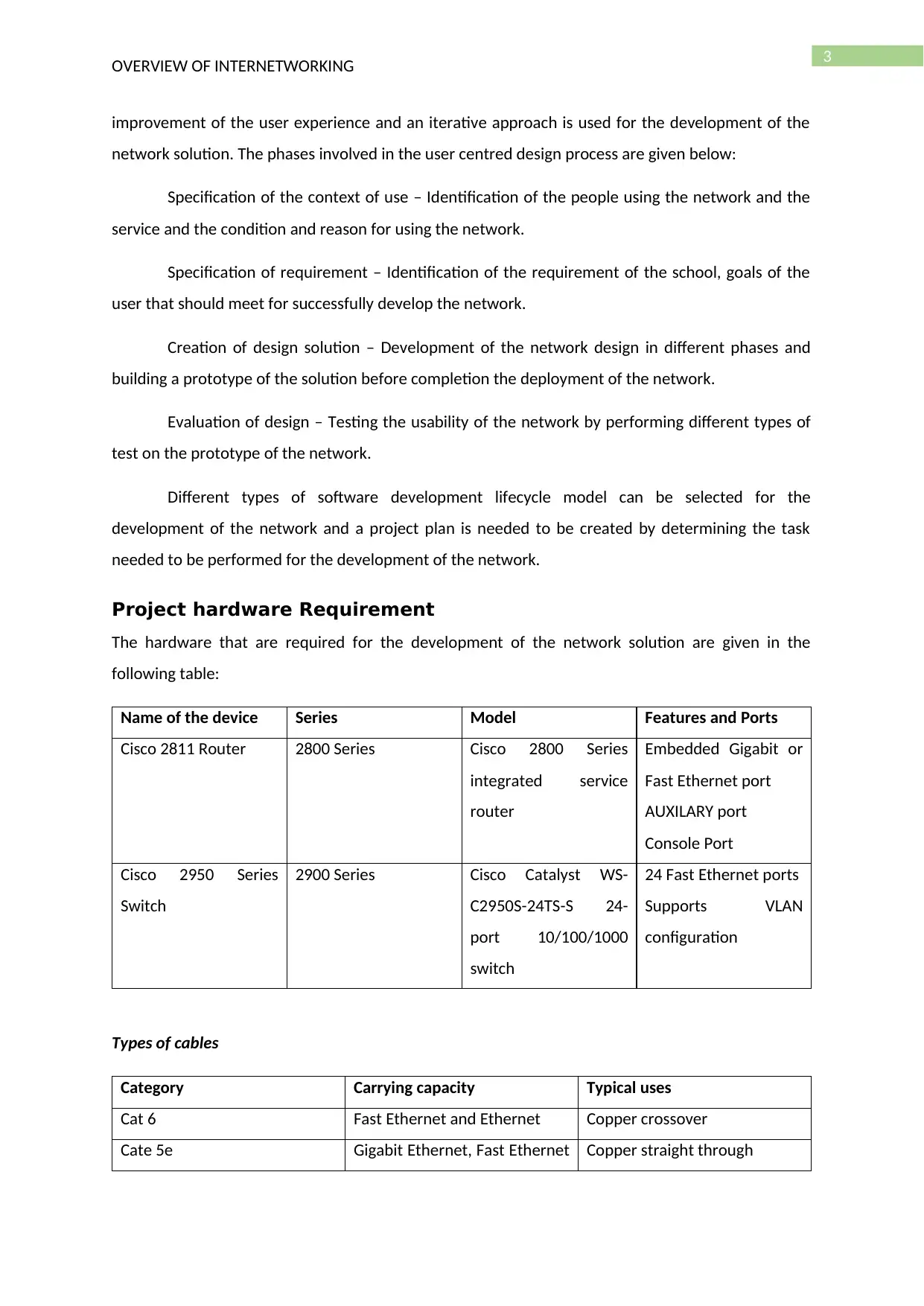
3
OVERVIEW OF INTERNETWORKING
improvement of the user experience and an iterative approach is used for the development of the
network solution. The phases involved in the user centred design process are given below:
Specification of the context of use – Identification of the people using the network and the
service and the condition and reason for using the network.
Specification of requirement – Identification of the requirement of the school, goals of the
user that should meet for successfully develop the network.
Creation of design solution – Development of the network design in different phases and
building a prototype of the solution before completion the deployment of the network.
Evaluation of design – Testing the usability of the network by performing different types of
test on the prototype of the network.
Different types of software development lifecycle model can be selected for the
development of the network and a project plan is needed to be created by determining the task
needed to be performed for the development of the network.
Project hardware Requirement
The hardware that are required for the development of the network solution are given in the
following table:
Name of the device Series Model Features and Ports
Cisco 2811 Router 2800 Series Cisco 2800 Series
integrated service
router
Embedded Gigabit or
Fast Ethernet port
AUXILARY port
Console Port
Cisco 2950 Series
Switch
2900 Series Cisco Catalyst WS-
C2950S-24TS-S 24-
port 10/100/1000
switch
24 Fast Ethernet ports
Supports VLAN
configuration
Types of cables
Category Carrying capacity Typical uses
Cat 6 Fast Ethernet and Ethernet Copper crossover
Cate 5e Gigabit Ethernet, Fast Ethernet Copper straight through
OVERVIEW OF INTERNETWORKING
improvement of the user experience and an iterative approach is used for the development of the
network solution. The phases involved in the user centred design process are given below:
Specification of the context of use – Identification of the people using the network and the
service and the condition and reason for using the network.
Specification of requirement – Identification of the requirement of the school, goals of the
user that should meet for successfully develop the network.
Creation of design solution – Development of the network design in different phases and
building a prototype of the solution before completion the deployment of the network.
Evaluation of design – Testing the usability of the network by performing different types of
test on the prototype of the network.
Different types of software development lifecycle model can be selected for the
development of the network and a project plan is needed to be created by determining the task
needed to be performed for the development of the network.
Project hardware Requirement
The hardware that are required for the development of the network solution are given in the
following table:
Name of the device Series Model Features and Ports
Cisco 2811 Router 2800 Series Cisco 2800 Series
integrated service
router
Embedded Gigabit or
Fast Ethernet port
AUXILARY port
Console Port
Cisco 2950 Series
Switch
2900 Series Cisco Catalyst WS-
C2950S-24TS-S 24-
port 10/100/1000
switch
24 Fast Ethernet ports
Supports VLAN
configuration
Types of cables
Category Carrying capacity Typical uses
Cat 6 Fast Ethernet and Ethernet Copper crossover
Cate 5e Gigabit Ethernet, Fast Ethernet Copper straight through
Paraphrase This Document
Need a fresh take? Get an instant paraphrase of this document with our AI Paraphraser

4
OVERVIEW OF INTERNETWORKING
and Ethernet
Fibre optics Gigabit Ethernet Backbone cabling and Serial
connection
Name of the server
The following servers are used for the management of different operation and service and meet the
needs of the users and are given below:
DHCP Server
o 3.5 Ghz CPU
o 8 Gb for 64 bit
o Windows Server 2016 x64
o Microsoft SQL Server 2016
o 1 Tb HDD
WEB Server
o 3.5 Ghz CPU
o 8 Gb Ram
o Windows server 2016 x64
o 1 TB hard Disk
Specification of the PC
o 2.5 Ghz dual core
o Windows 10 enterprise edition
o 4 Gb memory
o 500 Gb HDD
OVERVIEW OF INTERNETWORKING
and Ethernet
Fibre optics Gigabit Ethernet Backbone cabling and Serial
connection
Name of the server
The following servers are used for the management of different operation and service and meet the
needs of the users and are given below:
DHCP Server
o 3.5 Ghz CPU
o 8 Gb for 64 bit
o Windows Server 2016 x64
o Microsoft SQL Server 2016
o 1 Tb HDD
WEB Server
o 3.5 Ghz CPU
o 8 Gb Ram
o Windows server 2016 x64
o 1 TB hard Disk
Specification of the PC
o 2.5 Ghz dual core
o Windows 10 enterprise edition
o 4 Gb memory
o 500 Gb HDD
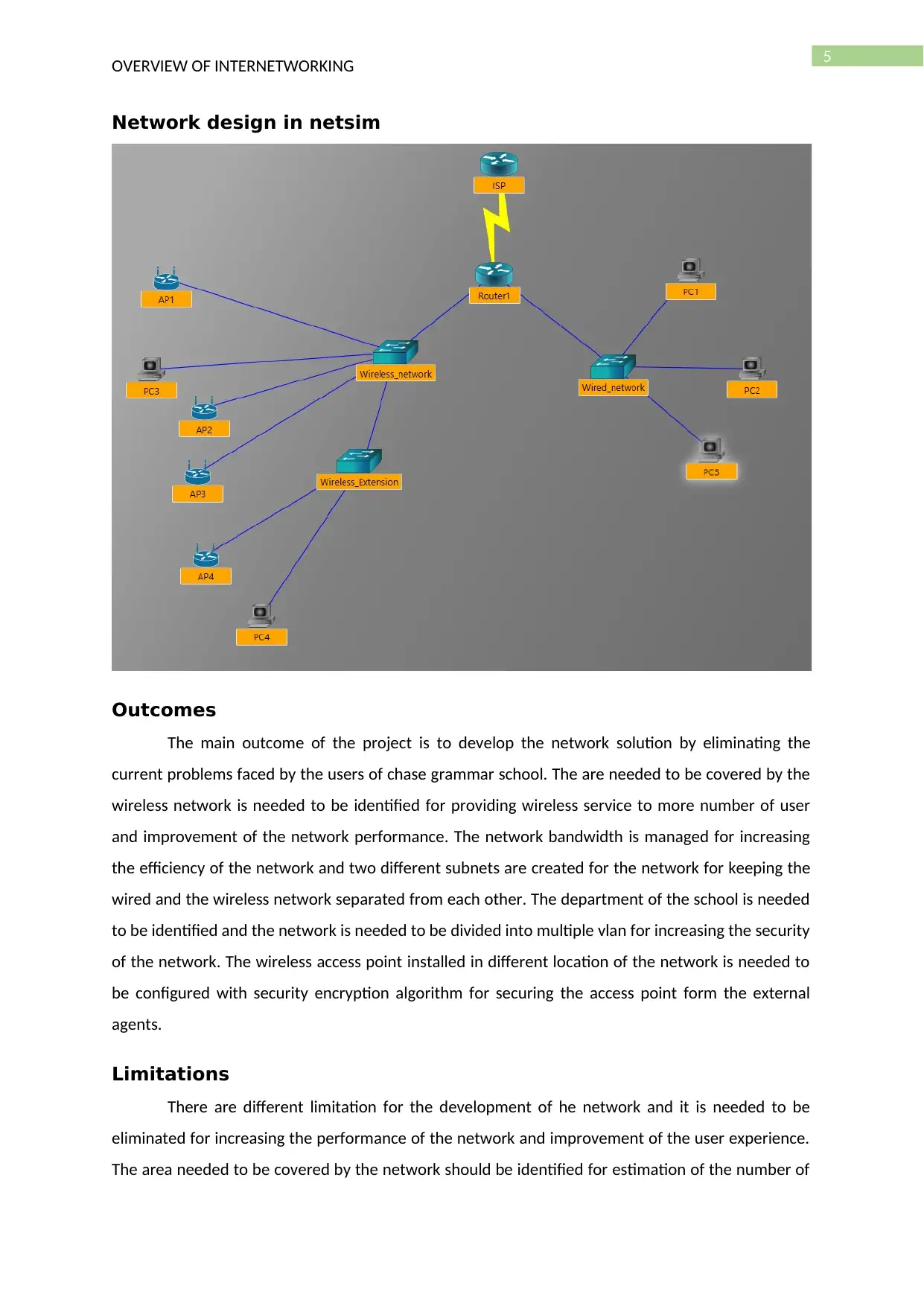
5
OVERVIEW OF INTERNETWORKING
Network design in netsim
Outcomes
The main outcome of the project is to develop the network solution by eliminating the
current problems faced by the users of chase grammar school. The are needed to be covered by the
wireless network is needed to be identified for providing wireless service to more number of user
and improvement of the network performance. The network bandwidth is managed for increasing
the efficiency of the network and two different subnets are created for the network for keeping the
wired and the wireless network separated from each other. The department of the school is needed
to be identified and the network is needed to be divided into multiple vlan for increasing the security
of the network. The wireless access point installed in different location of the network is needed to
be configured with security encryption algorithm for securing the access point form the external
agents.
Limitations
There are different limitation for the development of he network and it is needed to be
eliminated for increasing the performance of the network and improvement of the user experience.
The area needed to be covered by the network should be identified for estimation of the number of
OVERVIEW OF INTERNETWORKING
Network design in netsim
Outcomes
The main outcome of the project is to develop the network solution by eliminating the
current problems faced by the users of chase grammar school. The are needed to be covered by the
wireless network is needed to be identified for providing wireless service to more number of user
and improvement of the network performance. The network bandwidth is managed for increasing
the efficiency of the network and two different subnets are created for the network for keeping the
wired and the wireless network separated from each other. The department of the school is needed
to be identified and the network is needed to be divided into multiple vlan for increasing the security
of the network. The wireless access point installed in different location of the network is needed to
be configured with security encryption algorithm for securing the access point form the external
agents.
Limitations
There are different limitation for the development of he network and it is needed to be
eliminated for increasing the performance of the network and improvement of the user experience.
The area needed to be covered by the network should be identified for estimation of the number of
⊘ This is a preview!⊘
Do you want full access?
Subscribe today to unlock all pages.

Trusted by 1+ million students worldwide
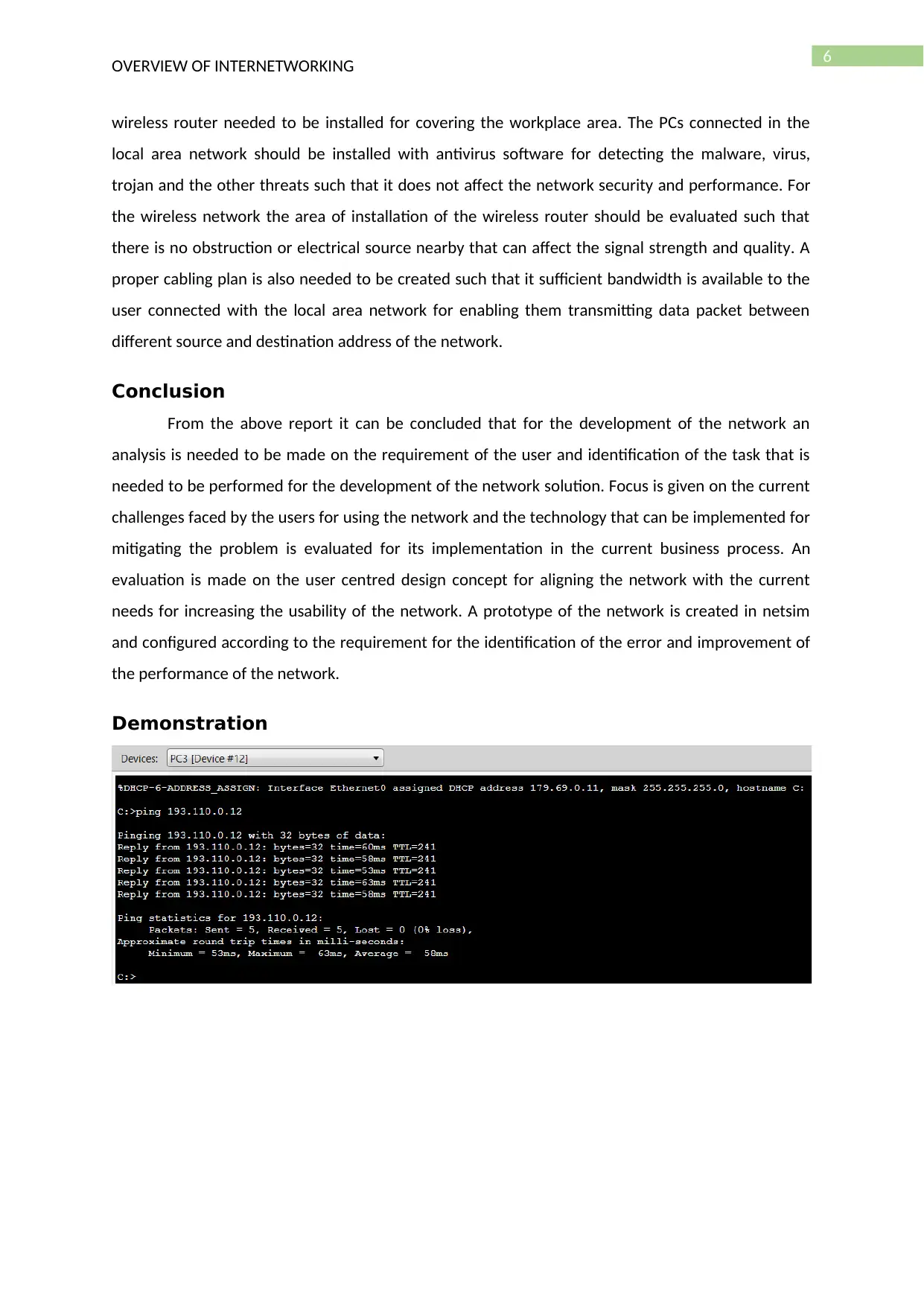
6
OVERVIEW OF INTERNETWORKING
wireless router needed to be installed for covering the workplace area. The PCs connected in the
local area network should be installed with antivirus software for detecting the malware, virus,
trojan and the other threats such that it does not affect the network security and performance. For
the wireless network the area of installation of the wireless router should be evaluated such that
there is no obstruction or electrical source nearby that can affect the signal strength and quality. A
proper cabling plan is also needed to be created such that it sufficient bandwidth is available to the
user connected with the local area network for enabling them transmitting data packet between
different source and destination address of the network.
Conclusion
From the above report it can be concluded that for the development of the network an
analysis is needed to be made on the requirement of the user and identification of the task that is
needed to be performed for the development of the network solution. Focus is given on the current
challenges faced by the users for using the network and the technology that can be implemented for
mitigating the problem is evaluated for its implementation in the current business process. An
evaluation is made on the user centred design concept for aligning the network with the current
needs for increasing the usability of the network. A prototype of the network is created in netsim
and configured according to the requirement for the identification of the error and improvement of
the performance of the network.
Demonstration
OVERVIEW OF INTERNETWORKING
wireless router needed to be installed for covering the workplace area. The PCs connected in the
local area network should be installed with antivirus software for detecting the malware, virus,
trojan and the other threats such that it does not affect the network security and performance. For
the wireless network the area of installation of the wireless router should be evaluated such that
there is no obstruction or electrical source nearby that can affect the signal strength and quality. A
proper cabling plan is also needed to be created such that it sufficient bandwidth is available to the
user connected with the local area network for enabling them transmitting data packet between
different source and destination address of the network.
Conclusion
From the above report it can be concluded that for the development of the network an
analysis is needed to be made on the requirement of the user and identification of the task that is
needed to be performed for the development of the network solution. Focus is given on the current
challenges faced by the users for using the network and the technology that can be implemented for
mitigating the problem is evaluated for its implementation in the current business process. An
evaluation is made on the user centred design concept for aligning the network with the current
needs for increasing the usability of the network. A prototype of the network is created in netsim
and configured according to the requirement for the identification of the error and improvement of
the performance of the network.
Demonstration
Paraphrase This Document
Need a fresh take? Get an instant paraphrase of this document with our AI Paraphraser
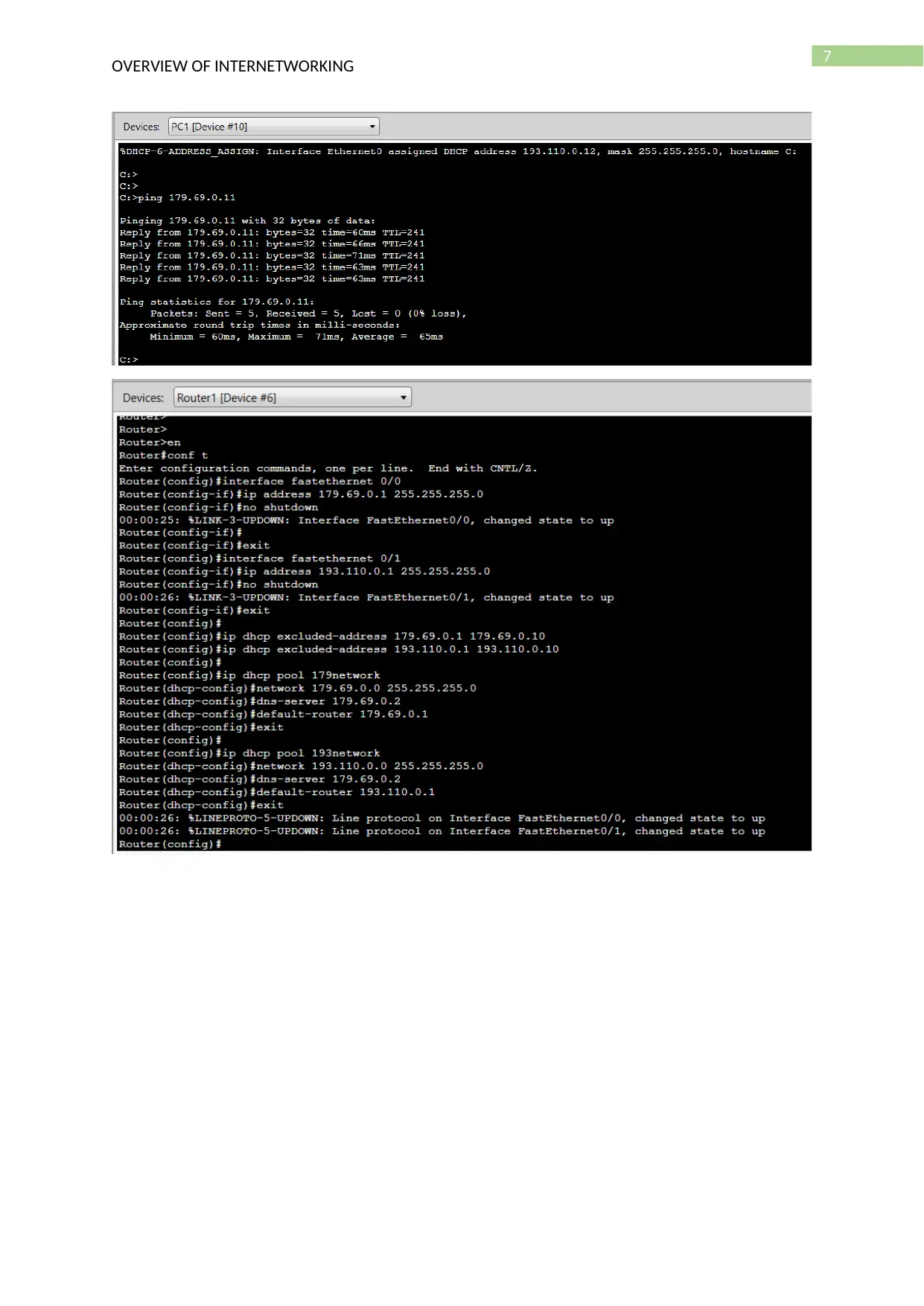
7
OVERVIEW OF INTERNETWORKING
OVERVIEW OF INTERNETWORKING
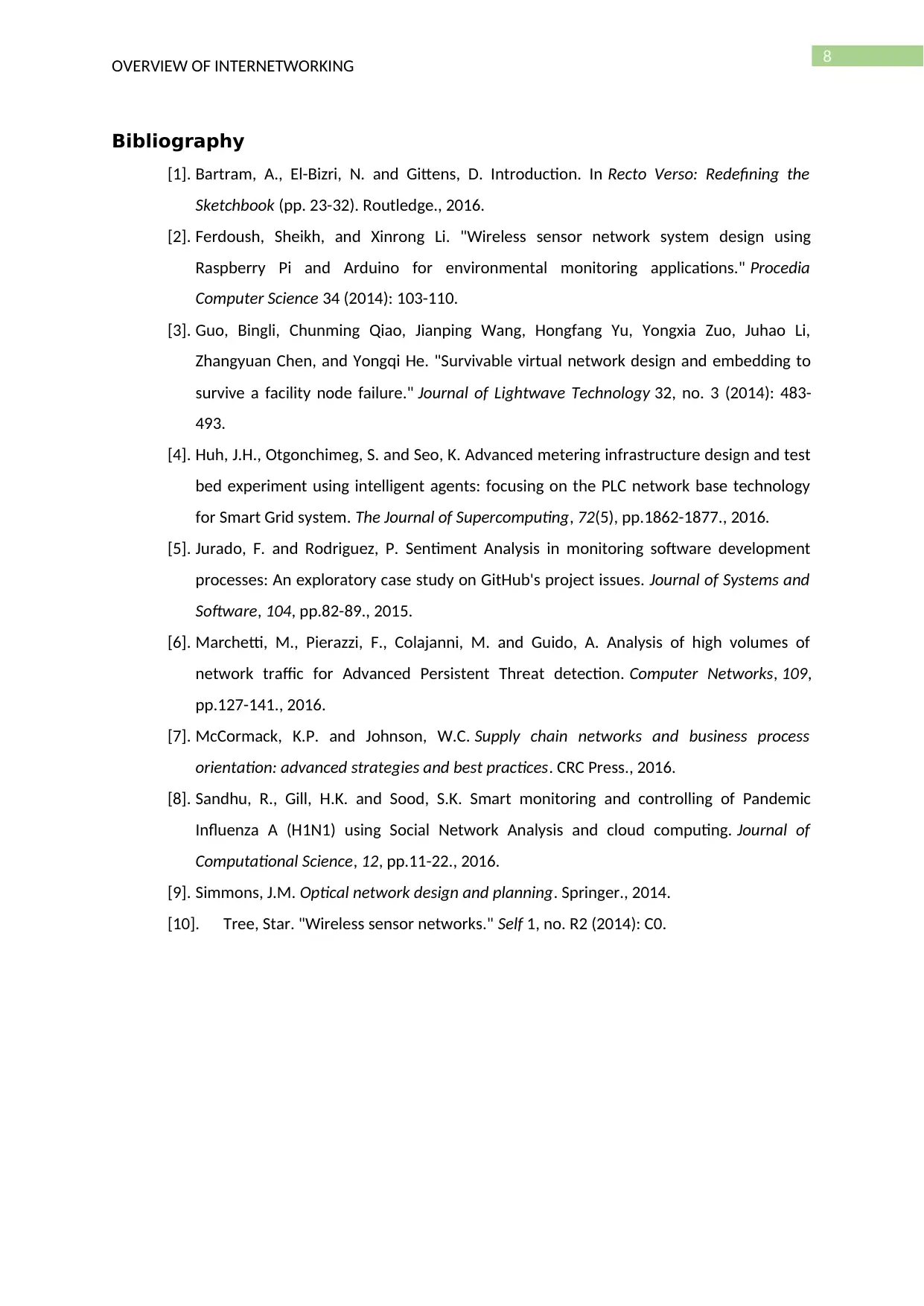
8
OVERVIEW OF INTERNETWORKING
Bibliography
[1]. Bartram, A., El-Bizri, N. and Gittens, D. Introduction. In Recto Verso: Redefining the
Sketchbook (pp. 23-32). Routledge., 2016.
[2]. Ferdoush, Sheikh, and Xinrong Li. "Wireless sensor network system design using
Raspberry Pi and Arduino for environmental monitoring applications." Procedia
Computer Science 34 (2014): 103-110.
[3]. Guo, Bingli, Chunming Qiao, Jianping Wang, Hongfang Yu, Yongxia Zuo, Juhao Li,
Zhangyuan Chen, and Yongqi He. "Survivable virtual network design and embedding to
survive a facility node failure." Journal of Lightwave Technology 32, no. 3 (2014): 483-
493.
[4]. Huh, J.H., Otgonchimeg, S. and Seo, K. Advanced metering infrastructure design and test
bed experiment using intelligent agents: focusing on the PLC network base technology
for Smart Grid system. The Journal of Supercomputing, 72(5), pp.1862-1877., 2016.
[5]. Jurado, F. and Rodriguez, P. Sentiment Analysis in monitoring software development
processes: An exploratory case study on GitHub's project issues. Journal of Systems and
Software, 104, pp.82-89., 2015.
[6]. Marchetti, M., Pierazzi, F., Colajanni, M. and Guido, A. Analysis of high volumes of
network traffic for Advanced Persistent Threat detection. Computer Networks, 109,
pp.127-141., 2016.
[7]. McCormack, K.P. and Johnson, W.C. Supply chain networks and business process
orientation: advanced strategies and best practices. CRC Press., 2016.
[8]. Sandhu, R., Gill, H.K. and Sood, S.K. Smart monitoring and controlling of Pandemic
Influenza A (H1N1) using Social Network Analysis and cloud computing. Journal of
Computational Science, 12, pp.11-22., 2016.
[9]. Simmons, J.M. Optical network design and planning. Springer., 2014.
[10]. Tree, Star. "Wireless sensor networks." Self 1, no. R2 (2014): C0.
OVERVIEW OF INTERNETWORKING
Bibliography
[1]. Bartram, A., El-Bizri, N. and Gittens, D. Introduction. In Recto Verso: Redefining the
Sketchbook (pp. 23-32). Routledge., 2016.
[2]. Ferdoush, Sheikh, and Xinrong Li. "Wireless sensor network system design using
Raspberry Pi and Arduino for environmental monitoring applications." Procedia
Computer Science 34 (2014): 103-110.
[3]. Guo, Bingli, Chunming Qiao, Jianping Wang, Hongfang Yu, Yongxia Zuo, Juhao Li,
Zhangyuan Chen, and Yongqi He. "Survivable virtual network design and embedding to
survive a facility node failure." Journal of Lightwave Technology 32, no. 3 (2014): 483-
493.
[4]. Huh, J.H., Otgonchimeg, S. and Seo, K. Advanced metering infrastructure design and test
bed experiment using intelligent agents: focusing on the PLC network base technology
for Smart Grid system. The Journal of Supercomputing, 72(5), pp.1862-1877., 2016.
[5]. Jurado, F. and Rodriguez, P. Sentiment Analysis in monitoring software development
processes: An exploratory case study on GitHub's project issues. Journal of Systems and
Software, 104, pp.82-89., 2015.
[6]. Marchetti, M., Pierazzi, F., Colajanni, M. and Guido, A. Analysis of high volumes of
network traffic for Advanced Persistent Threat detection. Computer Networks, 109,
pp.127-141., 2016.
[7]. McCormack, K.P. and Johnson, W.C. Supply chain networks and business process
orientation: advanced strategies and best practices. CRC Press., 2016.
[8]. Sandhu, R., Gill, H.K. and Sood, S.K. Smart monitoring and controlling of Pandemic
Influenza A (H1N1) using Social Network Analysis and cloud computing. Journal of
Computational Science, 12, pp.11-22., 2016.
[9]. Simmons, J.M. Optical network design and planning. Springer., 2014.
[10]. Tree, Star. "Wireless sensor networks." Self 1, no. R2 (2014): C0.
⊘ This is a preview!⊘
Do you want full access?
Subscribe today to unlock all pages.

Trusted by 1+ million students worldwide
1 out of 9
Related Documents
Your All-in-One AI-Powered Toolkit for Academic Success.
+13062052269
info@desklib.com
Available 24*7 on WhatsApp / Email
![[object Object]](/_next/static/media/star-bottom.7253800d.svg)
Unlock your academic potential
Copyright © 2020–2025 A2Z Services. All Rights Reserved. Developed and managed by ZUCOL.




